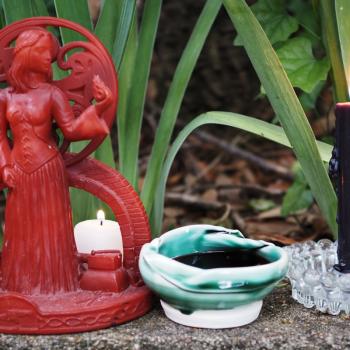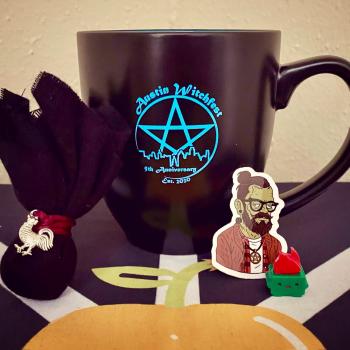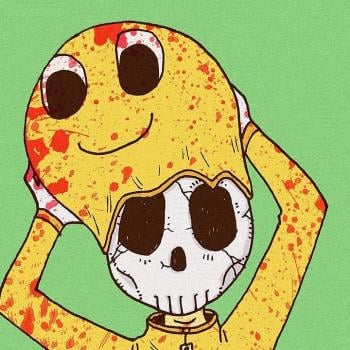It is, as the ditty goes, the most wonderful time of the year. And by that, I mean it’s when social media gets flooded with memes announcing that Easter and all of its related symbols derive from worship of the goddess Ishtar, along with an equal number of posts angrily denouncing those memes as fake history.
The idea that the Church “stole” key concepts from Paganism has prevailed for the better part of two centuries, and a lot of us (fairly logically tbh) assume that Eastery things like bunnies and colored eggs were originally Pagan before the Christians came along and scooped them all up. But as it turns out, the Church as a whole did not swipe quite as much from Paganism as initially suspected.
A Protestant with an axe to grind, though, most certainly did.
In 1853, a Scottish Presbyterian minister named Alexander Hislop published a pamphlet — later expanded into a full-length book — entitled The Two Babylons. And before we get into that, it’s important to understand that Hislop hated two things in life more than anything else:
- Fun.
- Catholicism.

Hislop’s works were heavily influenced by the theory of Panbabylonism, an offshoot of a larger school of thought called Hyperdiffusionism — the gist of which being that every culture around the globe evolved from a singular, ancient source. Those who adhered to Panbabylonism believed that source to be the Mesopotamian city of Babylon, and this was the basic premise of The Two Babylons. However, Hislop took things a step further and submitted that the Catholic Church was the direct descendant of a Babylonian mystery cult and was therefore inherently Pagan and corrupt, whereas Protestantism was the one, true path to salvation.
As one of the proofs of his assertions, Hislop pointed to Easter, claiming that the name was a cognate of the Near Eastern goddess Astarte, herself a cognate of the Babylonian goddess Ishtar. The alleged connection between Easter and Ishtar also served as his explanation as to why so many “fertility” symbols were associated with Easter.
And this is where things are going to get a little even more confusing as I paraphrase a bunch of history, but stay with me.
From ancient times up until whenever someone decided to, y’know, actually look at them, it was generally accepted that hares were hermaphroditic and reproduced through parthenogenesis. Since it was believed that they could spawn with their virginity intact, hares became a common emblem of the Virgin Mary in medieval European art.

Eggs have pretty much always symbolized rebirth in one way or another, so they understandably came to represent the resurrection of Jesus. Put the two together in, say, an illuminated manuscript, and you have Mary in the shape of a hare bringing forth the resurrected Christ in the form of an egg. Additionally, during Lent, it was standard practice to abstain from meat and dairy, including eggs. Eggs, then, became a special treat when Lent came to an end, which resulted in their long-standing Eastertide significance.
So now, let’s go back a little further to the eighth century, when Saint Bede (a.k.a. the Venerable Bede) wrote that Anglo-Saxons worshipped a goddess of the Spring named Eostre and dedicated an entire month to her (the name “Eostre” relating etymologically to a number of Germanic words that all roughly translate to “eastern”). Bede himself did not associate any animals or animal products with Eostre, but 1000 years later, the folklorist and fairy tale aficionado Jacob Grimm suggested that hares might could possibly have had something to do with Eostre. Which was all Alexander Hislop needed to bulk up his own hypotheses, thus conflating Eostre with his arch-nemesis Ishtar.
The point of all this being that the Easter Bunny is not a rabbit, but a hare. As a die-hard collector of weird lagomorphs, this brings me unbridled joy.

While summarily dismissed by modern academics, The Two Babylons was (and still is) embraced by some of the more aggressive Fundamentalists out there. Like, when you were a kid, did you ever get one of those evangelical Chick Publications tracts mixed in with your Halloween candy? If so, then you caught a glimpse of The Two Babylons in comic book format. But Hislop’s theories also provoked a lot of curiosity about the survival of pre-Christian religions, which acted as inspiration for later writers such as Jules Michelet and Charles Godfrey Leland, whose books paved the way for the Witchcraft Revival of the twentieth century. And that, in turn, led to the rise of contemporary Paganism.
So even though Hislop’s ultimate goal was to take down the Catholic Church, he inadvertently did modern Pagans a big favor. And for that we can be grateful.
Or else we can just kick back and enjoy the show as the Easter vs. Ishtar battles rage on. Whichever works for you will totally work for me.


















